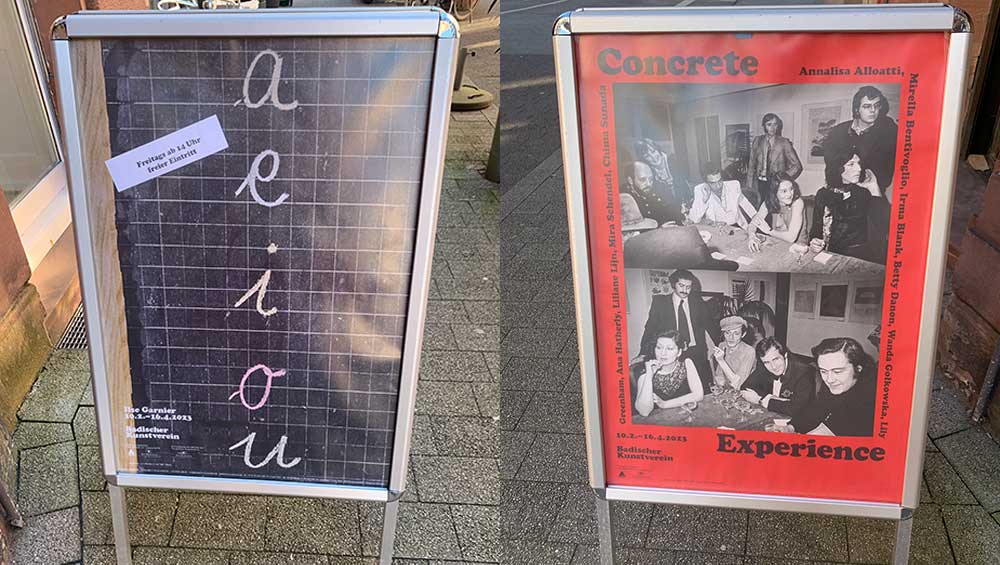
Posters for Ilse Garnier: a e i o u and Concrete Experience. Photo: Bronac Ferran.
Badischer Kunstverein, Karlsruhe
10 February – 16 April 2023
by BRONAĊ FERRAN
From the door of the Badischer Kunstverein, founded in 1818 and one of the oldest cultural venues in Germany, the staccato voice of the poet, artist and singer Lily Greenham (1924-2001) spills out into the street, forming an acoustic accompaniment to a poster stand on the pavement.1 On one side is a photograph of the first performance of Liliane Lijn’s Power Game in London in 1974 .2 Lijn (b1939, New York), was, like Greenham, born into a Jewish family and the parents of both artists suffered radical displacement during the tragic events of the second world war.
The poster stand is there to advertise two exhibitions now on at the museum, both relating to text-based works by female poets of the second half of the 20th century. Lijn’s photograph is the primary visual referent for a group exhibition featuring 10 artists and poets, linked eclectically under the rather generic title of Concrete Experience. The poster on the other side refers to the second exhibition, a e i o u, featuring works by the German-born French artist Ilse Garnier (1927-2020).
Both exhibitions have been co-curated by Anja Casser, director of the Badischer Kunstverein, and Alex Balgiu, a French-born design educator and writer, and the (male) co-editor (with Mónica de la Torre) of the 2021 anthology Women in Concrete Poetry, 1959-1979. Casser has said her interest in revisiting this material was stimulated by the anthology and the 2022 Venice Biennale, which highlighted the contribution of women to avant garde practices of the last century, including the work of several featured in this Karlsruhe exhibition. The 2022 focus, in turn, cast a line back to an exhibition at the 1978 Venice Biennale curated by the visual poet Mirella Bentivoglio (1922-2017). Bentivoglio chose the title Materializzazione del Linguaggio (Materialisation of Language) for what was the first significant international exhibition of female poets working experimentally with visual language. It is currently being revisited with a major exhibition in Italy.3 Several of those included in Concrete Experience, including Annalisa Alloatti, Irma Blank, Betty Danon and Mira Schendel, as well as Bentivoglio and Garnier, were featured in the 1978 exhibition.
This is Garnier’s first solo exhibition in Germany. As the opening room of a e i o u reveals, she first became known in the 1960s for extraordinary works in graphic, textual and visual language and in sound formats, much of it developed in collaboration with her husband, Pierre Garnier, a French-born editor, poet and professor of German literature. Together, they propagated what they called “spatialist” poetry, a term which they considered more apt than “concrete” poetry to describe what they were doing. They were extensively expanding use of the graphic space of the page, moving language out towards its edges and margins. Recognition of language as relating to sonic vibrations in space was also key to their sensibility, along with what the curators refer to as a “polyphonic approach” to language and a “continuous alternation between French and German”. The Garniers, like others were active in a postwar experimentation with language, in which new techniques such as Letraset and mimeographs were being added to traditional modes of typewriting and typesetting, to give agency to individual letters – not least the “vowels” – creating metalinguistic patterns and shapes and breaking with semantic meaning.
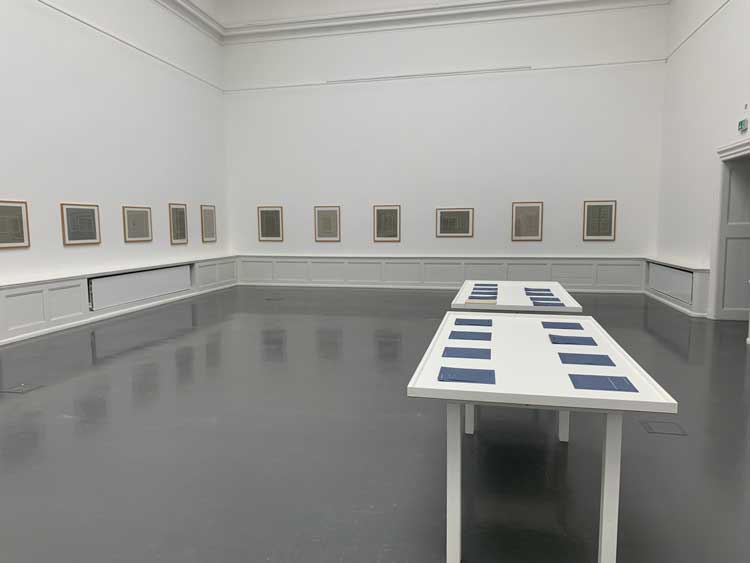
Ilse Garnier: a e i o u. Installation view, Badischer Kunsterverein. Photo: Bronac Ferran.
These were motifs also strongly elaborated in works made independently by Ilse Garnier from the early 70s to the 90s that form the primary curatorial focus of the rest of this exhibition. Spread through a series of large, high-ceilinged, white-walled rooms are multiple print-based works by Garnier laid out in stringently linear formations in wall-hung frames and glass-topped vitrines.
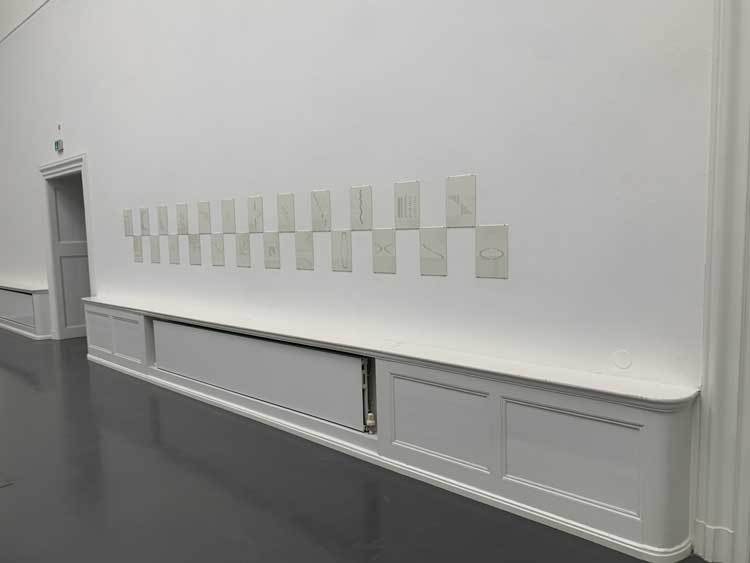
Ilse Garnier: a e i o u. Installation view, Badischer Kunsterverein. Photo: Bronac Ferran.
A highlight is a display of the 46 sheets of her Coat of Arms of the Female Body (1979), also shown at last year’s Venice Biennale. Notably, in an introductory text for this work when it was first published, reflecting the permeation of a relatively political consciousness into then contemporary discourse, Pierre Garnier noted that it was “depicting the poetic power of the female body that has been sapped by the patriarchal vision of history”. The clean display of the work within this exhibition facilitates a high degree of perceptual contemplation and stillness.
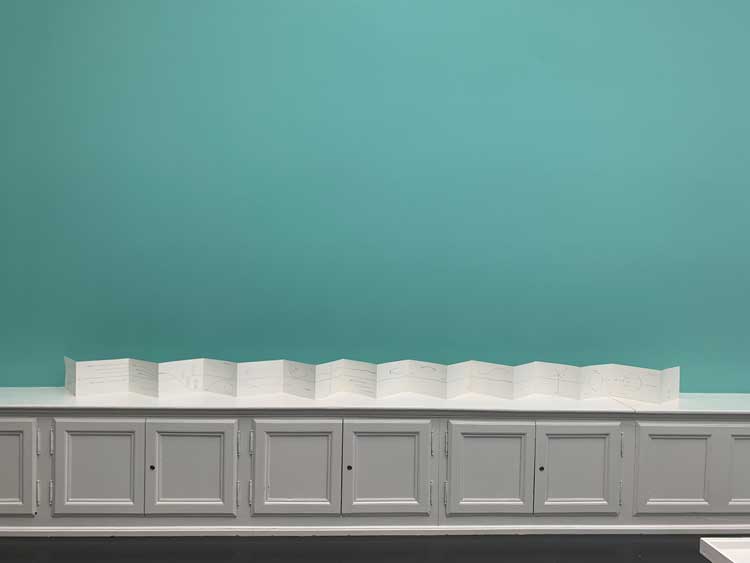
Ilse Garnier: a e i o u. Installation view, Badischer Kunsterverein. Photo: Bronac Ferran.
At the same time, other parts of the exhibition seek to stimulate degrees of playful, haptic, perceptual and embodied interaction. This is encouraged by a fruitful mix of multisensory experiences, from the building blocks of Garnier’s Puzzle Alphabet (played as a game of dice) to childlike chalk “hopscotch” drawings on the old stone floors of the building.

Ilse Garnier: a e i o u. Display of Garnier’s visual poems on gallery walls. Photo: Bronac Ferran.

Ilse Garnier: a e i o u. Garnier’s design for a game of hopscotch. Photo: Bronac Ferran.
Among the most compelling works on display are two projection-based pieces that show Garnier’s balancing of a spatialist and time-based approach to language, ahead of the mainstream arrival of digital multimedia practices in the 90s. One is entitled Voyage Cosmique (Cosmic Voyage) (1986), involving an innovative six-screen display (on four walls) of a time-based digital projection of a work by Garnier that up to now was unrealised, existing only in sketches. This strong curatorial intervention illuminates the non-linear and proto-generative nature of Garnier’s conceptual imaginary. Following close after is another highly effective installation, Les Marelles du Ciel (Hopscotch of the Sky), where a projection of light on to a spherical surface invites viewers to reflexively view the work (that, again, focuses primarily on the vowels) from multiple angles.

Ilse Garnier: a e i o u. Installation view of Les Marelles du Ciel, 1987. Photo: Bronac Ferran.
In contrast to the focused attention on Garnier and the calm distribution of her works over several spaces within the venue, works by those featured in Concrete Experience are mainly squeezed together within the downstairs atrium area. Here, we see a variety of asemic, calligraphic, conceptual, concrete, ideographic, kinetic, phonetic, semiotic, spatialist and visual poetry practices from the 60s onwards, with 21 works in total represented. Visitors may find that it is sometimes difficult to navigate the tightly adjacent nature of what is on display; a sense of crowding together of so many works into one area produces a sense of aural, spatial and visual distraction.

Concrete Experience, installation view of Chima Sunada’s Heart, 2018, See, 2020, and Love, 2021. Ink on Japanese paper. Photo: Bronac Ferran.
At the same time, there are some spellbinding works, including framed wall-based pieces by the Japanese artist Chima Sunada (b1944), who has specialised in a style of calligraphy called shodō, which means “the way of writing”. Her use of traditional ideograms and pictograms is viewed by the curators as having a connection to concrete poetry. A work entitled Cecità from 1975, a folder with five sheets, by the Italian poet Alloatti (1926-2000), written with a Braille typewriter, is also a substantial highlight.
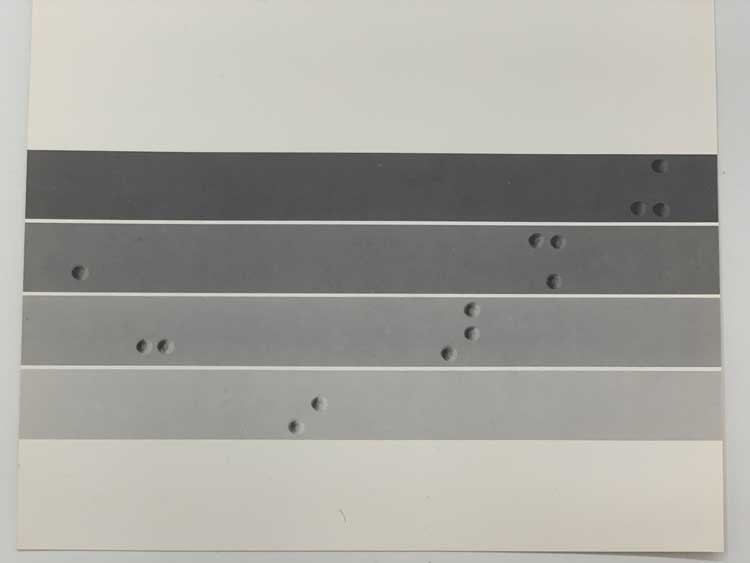
Concrete Experience, installation view of Annalisa Alloatti’s Cecità, 1975. Braille typewriter on paper. Photo: Bronac Ferran.
The exhibition includes three (relatively recent) examples of Lijn’s Poemcons, a kinetic and dynamic non-linear format that she invented in the early to mid-60s, during which time she also made the world’s first turning “poem machines”, which she has since developed in multiple modes and manifestations. Examples of these are being shown on a large-screen installation on one side of the gallery. Four of Lijn’s astonishing Neurographs from 1971, made with Letraset and Letrafilm, are also hung together. As the curatorial text tells us, by “use of electronic symbols and codes”, Lijn invented “an autonomous language based on figurative metaphors that characterise processes of psychic or unconscious experience such as delirium or dreaming”.
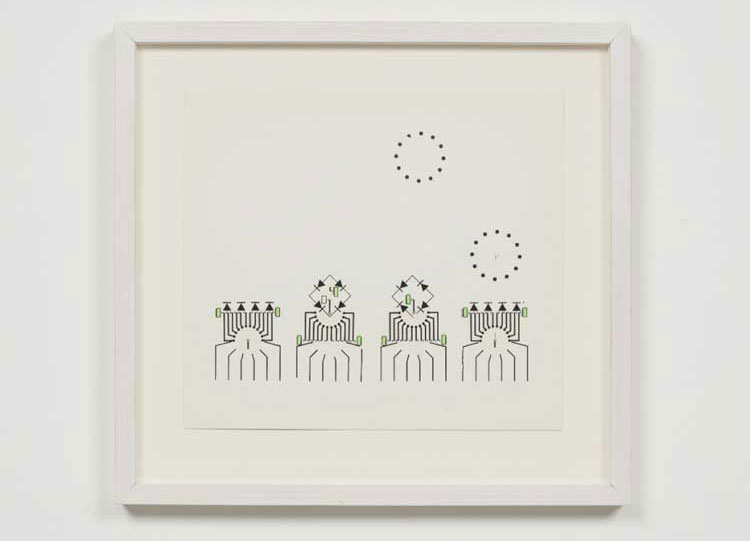
Liliane Lijn, Dream Robots, 1971. From Neurographs series (1970-1971). Letrafilm and Letraset on paper. Photo: Ronald Lewis.
I was thrilled also to see an extraordinary series of semiotic works on paper made by Danon in 1976. These are entitled Punto Linea (Point Line) and play with dots and lines and the spaces in between. Danon was born in Istanbul in 1927, but in 1956 moved to Milan, where she lived until her death in 2002. Although described in the curatorial commentary as a concrete poet, Danon herself, writing in 1987 about her work from the late 60s onwards, referred to “developing a personal visual poetic meta-language”, stating: “Upon the severe and cruel rigidity of the staves I impress my writing, initially made of punto-linea, which becomes more and more gestural and free in time. The Sound will become the real protagonist in my work, simply on the basis of its absence.”

Concrete Experience, installation view, cover of Betty Danon’s Punto-Linea, 1976. Photo: Bronac Ferran.

Concrete Experience. Co-curator Alex Balgiu beside Ana Hatherly’s Alfabeto estrutural (structural alphabet), 1967. Drawing on paper. Photo: Bronac Ferran.
A linguistically elemental turn was evident also in the multilayered practice of Ana Hatherly, who was a singularly early concrete poet in Portugal, making works in this domain from 1959 onwards. Here, she is represented by one work only, her nine-part Alfabeto Estrutural (Structural Alphabet) from 1967, based on the letter A, the play of which reveals the infinite extensibility of language. The letter E, meanwhile, gains a heightened presence within works by Bentivoglio, including E Congiunzione (And Conjunction) and Dalla E l’Architettura (From E the Architecture), both from 1973. The latter can be found in a “reading room” on the gallery’s first upper level, where an assemblage of anthologies, catalogues and publications relating to the history of concrete and visual poetry are available for browsing, along with Garnier’s Puzzle Alphabet and with a vintage IBM typewriter inviting interaction.

Concrete Experience. Mirella Bentivoglio’s E CONGUNZIONE (and conjunction), 1973. Installation view. Photo: Bronac Ferran.
References
1. Lily Greenham is performing Experience, from her collection Lingual Music, published by Paradigm Discs, London, 2007, available here.
2. For more on Liliane Lijn’s first Power Game, performed at an arts festival for democracy in Chile, the recording of which was shown at the Royal College of Art in 1974, see here.
3. Details of the Re-Materialisation of Language exhibition are available here.
• A series of family workshops and public events, including a symposium, have been organised to accompany these exhibitions.